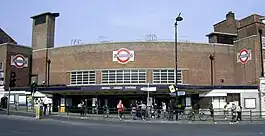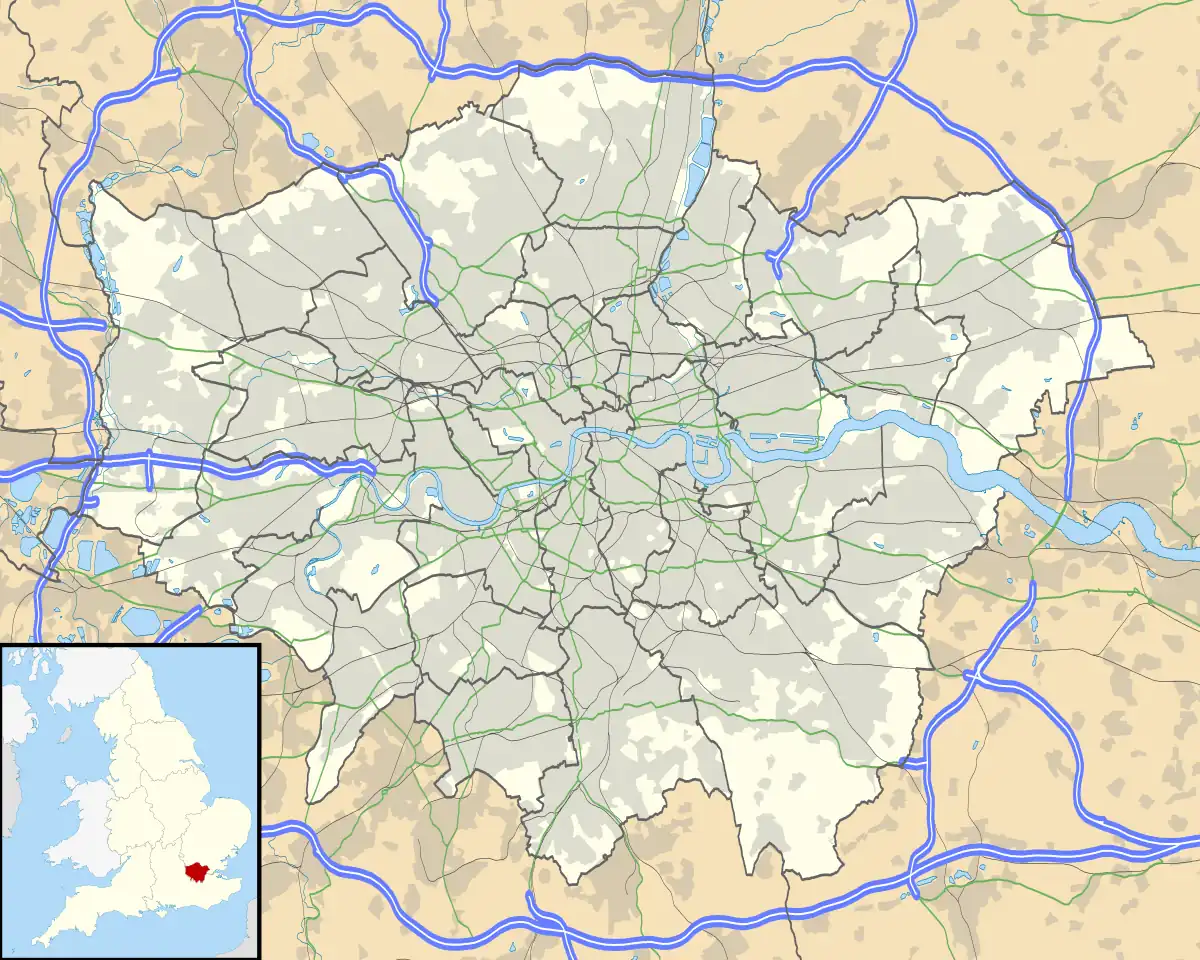| Wood Green | |
|---|---|
 | |
 Wood Green Location of Wood Green in Greater London | |
| Location | Wood Green |
| Local authority | London Borough of Haringey |
| Managed by | London Underground |
| Number of platforms | 2 |
| Fare zone | 3 |
| London Underground annual entry and exit | |
| 2018 | |
| 2019 | |
| 2020 | |
| 2021 | |
| 2022 | |
| Key dates | |
| 19 September 1932 | Opened (Piccadilly Line) |
| Listed status | |
| Listing grade | II |
| Entry number | 1401120[6] |
| Added to list | 20 July 2011 |
| Other information | |
| External links | |
| WGS84 | 51°35′49″N 0°06′36″W / 51.597°N 0.11°W |
Wood Green is a London Underground station on the Piccadilly line. The station is between Turnpike Lane and Bounds Green stations and is in Travelcard Zone 3. It is located at junction of High Road, Wood Green and Lordship Lane. It serves Wood Green Shopping City and the nearby Haringey Council administrative complex as well as a densely populated residential area. It is also the closest tube station to Alexandra Palace.
History
The station opened on 19 September 1932 when the first section of the Cockfosters extension from Finsbury Park was opened.
Like all stations on the extension, Wood Green set new aesthetic standards, not previously seen on London's Underground. When the Cockfosters extension was planned, alternative names for this station—"Lordship Lane" and "Wood Green Central"—were considered, but rejected. Architecturally, this station, designed by Charles Holden, is a well-preserved example of the modernist house style Holden developed for London Transport in the 1930s. Located on a corner site, the main frontage is curved and is flanked by two ventilation towers, although these are later additions to the station. On the northern side, the structure also incorporates a shop which forms part of the parade in High Road. The other end of the parade features a large London Underground sub-station.
Since July 2011, the station has been a grade II listed building, which now means every station building between Turnpike Lane and Cockfosters is listed.
The below surface areas of the station are tiled in biscuit-coloured tiles lined with green friezes. The station tunnels—in common with those of Manor House and Turnpike Lane—are 23 ft (7 m) diameter and were designed for the greater volume of traffic expected. In contrast, the platform tunnels at both Bounds Green and Southgate have a diameter of only 21 ft (6.4 m). The construction of "suicide pits" between the rails was a new innovation.
To the north of the station is a reversing siding. This is used for reversing northbound trains so that they can return towards central London and Heathrow Airport or Uxbridge. Until the 1990s trains were regularly turned back here – now only one train per day Monday to Thursday is scheduled to reverse at Wood Green, with the siding used mostly in times of service disruption, or to regain time after late running.
On 16 March 1976, the station was the site of a Provisional IRA bombing, when a device exploded on an empty train as it prepared to enter the reversing siding, before heading west to pick up football supporters at Arsenal. There was one passenger standing on the platform and was injured by flying glass.[7]
The National Rail station now called Alexandra Palace was formerly called Wood Green; it was renamed in 1984.
Services
| Preceding station | Following station | |||
|---|---|---|---|---|
| Turnpike Lane | Piccadilly line | Bounds Green towards Cockfosters or Arnos Grove | ||
Crossrail
With the Chelsea-Hackney line, otherwise known as Crossrail 2 under discussion, proposals have included Wood Green as a possible station on a spur between Angel and Alexandra Palace stations.[8] Wood Green station is a route option between New Southgate and Seven Sisters in the 2015 consultation.[9]
References
- ↑ "Station Usage Data" (CSV). Usage Statistics for London Stations, 2018. Transport for London. 23 September 2020. Archived from the original on 14 January 2023. Retrieved 11 October 2023.
- ↑ "Station Usage Data" (XLSX). Usage Statistics for London Stations, 2019. Transport for London. 23 September 2020. Archived from the original on 9 November 2020. Retrieved 9 November 2020.
- ↑ "Station Usage Data" (XLSX). Usage Statistics for London Stations, 2020. Transport for London. 16 April 2021. Retrieved 1 January 2022.
- ↑ "Station Usage Data" (XLSX). Usage Statistics for London Stations, 2021. Transport for London. 12 July 2022. Retrieved 7 September 2022.
- ↑ "Station Usage Data" (XLSX). Usage Statistics for London Stations, 2022. Transport for London. 4 October 2023. Retrieved 10 October 2023.
- ↑ Historic England. "Wood Green Underground Station (1401120)". National Heritage List for England. Retrieved 3 April 2015.
- ↑ "1976: Tube driver shot dead". On This Day. BBC News Online. 15 March 1976. Archived from the original on 30 June 2003.
The day after this incident a man was injured when a bomb exploded on a tube train at Wood Green, in north London.
- ↑ "Metro or regional rail? TfL maps Crossrail 2 options". TransportXtra. Archived from the original on 22 November 2011.
- ↑ Crossrail 2 October 2015
External links
- "Photographic Archive". London Transport Museum. Archived from the original on 18 March 2008.